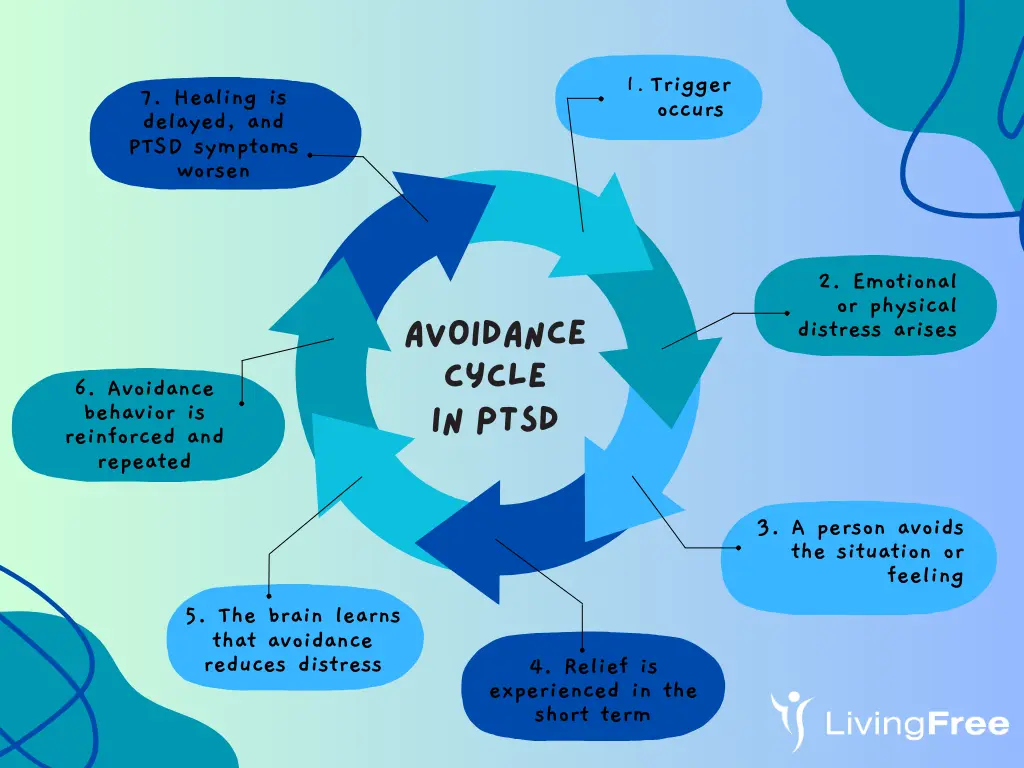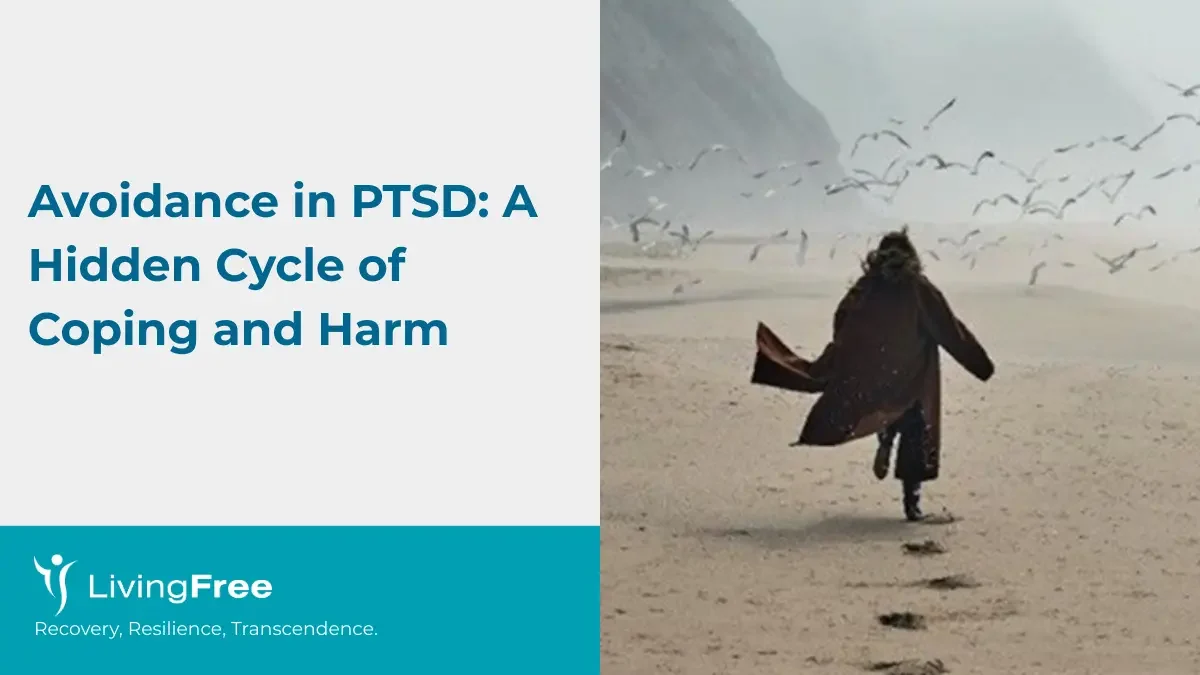Avoidance is one of the defining features of post-traumatic stress disorder (PTSD), often misunderstood and easily overlooked. For many trauma survivors, avoidance starts as a way to stay safe. But when it is left unresolved, it can hinder the healing process. Understanding the types, impact, and ways to overcome avoidance is crucial in managing PTSD and moving toward recovery.
What Is Avoidance in PTSD?
Avoidance is the attempt to distance oneself from anything that brings back memories of a traumatic experience. The source can be external, like avoiding people, places, or activities related to the trauma. Or internal, like suppressing thoughts, emotions, or memories associated with it. It is a core symptom of PTSD listed in the DSM-5-TR and can significantly interfere with daily functioning.
Types of Avoidance
Avoidance in PTSD often shows up in subtle ways. Avoiding reminders, numbing emotions, or keeping the mind busy to escape painful thoughts. While it may seem protective, it actually can deepen the struggle. Let’s explore the different forms of avoidance more closely below.
1. Behavioral Avoidance
Avoiding places, people, conversations, or situations that may trigger reminders of the trauma. For example:
- A survivor of a car crash may refuse to drive again.
- A veteran may avoid crowds or public events.
2. Emotional Avoidance
Suppressing or disconnecting from emotions associated with trauma. This can lead to emotional numbness or detachment. For example:
- Avoiding sadness, fear, or anger.
- Becoming emotionally “shut down” to prevent feeling pain.
3. Cognitive Avoidance
Trying to push away or block out memories and thoughts of the trauma. For example:
Refusing to think or talk about the event.
- Distracting oneself with excessive work or entertainment.
- Related Post: Psychological Trauma: Symptoms, Causes, and How to Heal
Examples of Avoidance Behavior in PTSD
Avoidance often happens when someone tries to steer clear of things that bring up memories of trauma or big, overwhelming feelings. It might feel like it helps for a little while, but in the long run, it can make the healing process take longer. Below are common examples of avoidance behavior seen in individuals with PTSD, with explanations:
Using Alcohol or Drugs to Blunt Emotions
Substance use serves as an emotional numbing tool. A person may use alcohol or drugs to suppress distressing feelings like fear, guilt, or sadness. While it may feel like an escape, over time it leads to dependency and worsened PTSD symptoms.
Engaging in Wishful Thinking or Maladaptive Daydreaming
Escaping into fantasy can help avoid painful emotions or reality. However, it may prevent people from processing trauma and participating in daily life.
Suppressing Emotions Instead of Processing Them
Emotional suppression might seem protective, but it often results in emotional numbness or future emotional outbursts when those repressed feelings inevitably surface.
Isolating From Others
Individuals may avoid social interaction due to fear of being triggered or judged. Isolation increases the risk of depression and reduces access to support.
Avoiding Eye Contact
Trauma survivors often avoid eye contact to protect against perceived threats or vulnerability.
Making Excuses to Avoid Social Gatherings or Leaving Early
Avoiding events helps sidestep potential triggers but may reinforce avoidance and increase loneliness.
Procrastinating on Important Tasks
Trauma-related anxiety can make even basic responsibilities feel overwhelming. Chronic procrastination adds guilt and stress.
Canceling Plans at The Last Minute
Individuals may feel overwhelmed by anxiety when the time comes to follow through, leading to sudden cancellations and missed opportunities for connection.
Related Post: Can You Have PTSD Without Knowing It?
The Impact of Avoidance
Avoidance may feel like a quick fix, but it often comes with hidden costs. Continually pushing away trauma reminders can cause life to feel smaller, strain relationships, and slow down recovery. It turns avoidance into a cycle that quietly strengthens the effects of PTSD.
- Hindered Recovery
Avoidance blocks emotional processing, preventing trauma from being integrated and resolved.
- Social Isolation
Withdrawing from others may feel safer, but it leads to loneliness and disconnection.
- Impaired Emotional Regulation
Avoidance inhibits learning to manage distress, often leading to emotional suppression or outbursts.
- Anxiety and Depression
Avoidance maintains fear and creates a sense of helplessness, worsening mental health.
- Decreased Quality of Life
Avoidance limits joy, productivity, and growth. Worse, it can affect relationships, career, and personal fulfillment.
Related Post: Understanding PTSD: Re-experiencing, Emotional Numbing, and Hyperarousal
Why Avoidance Happens
Avoidance is a protective mechanism. It provides short-term relief by helping people escape emotional pain or reminders of danger. However, it also prevents the brain from properly processing the trauma, which blocks recovery.
When triggers are avoided, the brain learns to treat them as dangerous even if they are harmless. This creates a cycle that fuels anxiety, avoidance, and ongoing PTSD symptoms.
The Avoidance Cycle
Avoidance in PTSD doesn’t just happen once: it often repeats, creating a cycle that feels safe in the moment but harmful in the long run. Each attempt to escape reminders can tighten the grip of trauma. Let’s explore how each step and cycle takes shape below.

Trigger occurs > Emotional or physical distress arises > A person avoids the situation or feeling > Relief is experienced in the short term > The brain learns that avoidance reduces distress > Avoidance behavior is reinforced and repeated > Healing is delayed, and PTSD symptoms worsen.
And repeat, this cycle will continue to repeat itself as long as avoidance in PTSD is not handled properly.
Related Post: Are You Experiencing Hyperarousal?
How To Break The Cycle of Avoidance in PTSD
Escaping reminders of trauma may feel safe, but real healing begins when the cycle of avoidance is gently interrupted. Breaking free doesn’t mean rushing into painful experiences, it means building safe and gradual steps toward facing what feels overwhelming while strengthening inner resilience along the way.
Trauma-Focused Therapy
Treatments like Cognitive Processing Therapy (CPT), Eye Movement Desensitization and Reprocessing (EMDR), and Prolonged Exposure (PE) therapy help individuals face trauma safely.
Mindfulness-Based Interventions
Mindfulness-Based Stress Reduction (MBSR) and Mindfulness-Based Cognitive Therapy (MBCT) train individuals to observe thoughts without judgment.
Gradual Exposure
Exposure therapy helps people slowly face feared situations under the guidance of a therapist, reducing fear over time.
Support Systems
Rebuilding trust and connection through friends, family, or peer support groups fosters emotional safety and accountability.
Creative Therapies
Expressive outlets such as art, writing, and music provide non-verbal paths to process trauma and reduce emotional avoidance.
Psychoeducation
Learning how avoidance works can help normalize the experience and motivate individuals to take healing steps.
Final Thoughts
Avoidance in PTSD may feel like self-protection, but over time, it keeps survivors stuck in the pain of the past. The good news is, healing is possible. With gradual steps, strong support, and professional guidance, it’s possible to break the cycle, face trauma safely, and rebuild a life filled with connection and hope.
If it feels too heavy to manage alone, don’t hesitate to seek professional help. Healing is possible, and you don’t have to go through it by yourself. If you’re ready to take the next step, Contact Us here!


